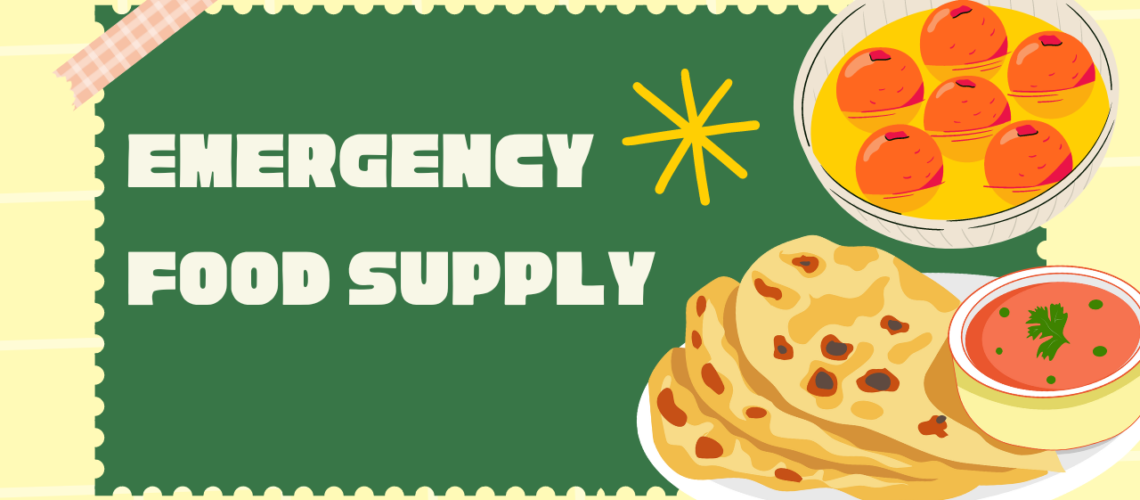Emergency Food Supply: A Comprehensive Guide
August 31, 2024

Keeping an emergency food supply on hand is an essential part of disaster preparedness in an unpredictable environment. Emergency Food Supply Food systems can be upset by natural catastrophes, economic downturns, pandemics, and other emergencies, so having a well-thought-out strategy to support your family is crucial. The significance of having emergency food supplies, what to put in them, how to store them, and maintenance advice will all be covered in this article.
Why You Need an Emergency Food Supply
1. Natural Disasters
Natural disasters such as hurricanes, earthquakes, floods, and wildfires can occur suddenly and cause interruptions to the supply chain and food shortages. Having a backup food supply guarantees that you can weather these calamities without having quick access to supermarkets.
2. Economic Instability
Economic downturns can result in inflation or job losses, which makes it more difficult to afford food. Keeping a stockpile might help you keep a healthy diet stress-free during hard times by easing financial difficulties.
3. Health Crises
Quarantine restrictions or restricted access to stores may result from pandemics or other health emergencies. Having a well-stocked emergency food stockpile means you won’t have to go outside when things are bad.
4. Self-Sufficiency
Creating a food reserve for emergencies promotes self-sufficiency. In unpredictable times, having confidence in your ability to support yourself and your loved ones can ease your mind.
Things to Put in Your Emergency Food Kit
1. Non-Perishable Foods
Consider non-perishable foods with extended shelf lives when choosing food items:
- Products in cans: fruits, vegetables, meats, soups, and beans.
- Foods that are dried: grains, rice, lentils, and pasta.
- Freeze-Dried Meals: Meals that are freeze-dried are lightweight, simple to make, and perfect for last-minute situations.
- Nut butters: Rich in good fats and protein, these can take the place of meals.
- Snacks: Dried fruits, almonds, and granola bars give you energy quickly.
2. Water
Food and water are essential. Try to get at least one gallon per person each day and try to have enough for at least two weeks. If there is any contamination, think about purifying the water.
3. Baby and Special Dietary Needs
Make sure you have the right food and materials on hand for anyone who has dietary requirements, is old, or is a newborn.
4. Cooking Essentials
Never neglect the necessities for cooking:
Manual Can Opener: A can opener is a must if you own canned products.
Cooking Fuel: Keep a supply of propane, charcoal, and other cooking fuels on hand.
Paper plates and utensils: can come in handy when there enough water to wash dishes.
5. Nutritional Supplements
Incorporating multivitamins or other dietary supplements might help guarantee that your family has enough nourishment in times of need.
How to Store Your Emergency Food Supply
1. Choose the Right Location
Keep your emergency food out of direct sunlight and in a cool, dry spot. Pantries, closets, and basements can all be good places.
2. Use Airtight Containers
Food should be kept dry and free of pests by being stored in sealed containers. For extended storage, mylar bags with oxygen absorbers work really well.
3. Rotate Your Stock
Use the First In, First Out (FIFO) principle to make sure that older things are used first. Replace any expired items and keep an eye out for expiration dates.
4. Label Everything
Put the contents and expiration dates on the labels of your containers. This makes it easier for you to determine what you already have and what needs to be replace or use.
Tips for Maintaining Your Emergency Food Supply
1. Regular Inventory Checks
To make sure your supply is complete and current, schedule routine inventory checks. This exercise will assist you in determining what needs to be restocke.
2. Educate Your Family
Make sure that everyone in the household is aware of the location and usage of the emergency food supply. To simulate emergency scenarios, conduct drills.
3. Meal Planning
To make the most of your materials, think about organizing your meals. Make meals that make use of your emergency food supplies to familiarize and de-stress them.
4. Stay Informed
Keep abreast of changes in food patterns, storage methods, and disaster readiness. Knowing what to expect will help you modify your plan as necessary.
Conclusion
A crucial component of preparedness that can offer security and comfort during emergencies is an emergency food supply. You and your love ones will be prepared for any obstacles that may arise if you recognize the value of having a stockpile, know what to include, and put good storage and maintenance practices into place. By evaluating your present food supplies and increasing them to suit your family’s needs, take the first step now.